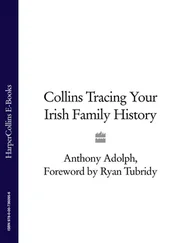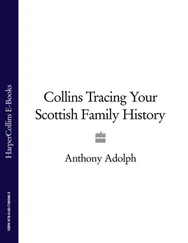The main point at this stage is to write everything down. Be they oral or written, quote your sources precisly. Later, you can interpret the sources, but if you do this initially and discard the original information, and then find that your interpretation of the sources had been wrong, you (or someone else trying to help you – and, believe me, I’ve been there!) may have a terrible time disentangling what is correct from what is not. This applies just as much to interviewing people as to record-based research. In addition, always write down exactly what records you were searching, for what periods and for what you searched. If you do, and later you find that you are stuck, you may rely on your notes to tell you, say, that you looked under Thompson and also Thomson, thus potentially saving yourself a repeat journey to a record office to perform a search you had, in fact, already carried out but forgotten about.

OLD FAMILY TREES were drawn with the names of parents in circles and their children radiating out below them. This arrangement was thought to resemble the footprints of Cranes in the soft mud of river banks, hence their name ‘Crane’s foot’ – ‘pied de Cru’ – pedigree!

There are several different types of family tree. These are:
‘Family trees’ and ‘pedigrees’, sometimes prefixed with the term ‘dropline’ (a chart with the earliest ancestor at the top and each subsequent generation connected by dropping lines), are one and the same – charts depicting a line or lines of ancestry.
‘Narrative pedigrees’, which are family trees written down in paragraphs, a style that is used by Burke’s Peerage and which is a highly effective way of recording a lot of information in a small space, but which isn’t so good for easily seeing who’s related to who. It is not much use for conducting original research, when only a family tree will make everything clear.
Seize quartiers, which spread out either like trees or in concentric circles, to show both parents, all four grandparents, the eight great-grandparents and – if you can manage it – all 16 great-greats. The original purpose of seize quartiers was snobbish, as you had to prove that all 16 were noble if you wanted to join foreign orders of knighthood like the Golden Fleece. Now, however, they are a good way of showing you have traced your family exhaustively. But don’t feel obliged and become exhausted, this is supposed to be fun and you can aim to trace as much or as little as you want.
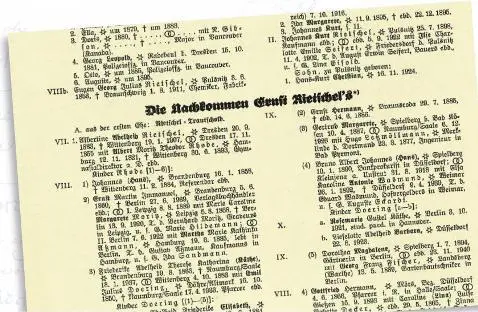
Part of my mother’s family tree, showing how Germans Printed pedigrees in the 1930s.
= Indicates a marriage, accompanied by ‘m.’ and the date and place
— Solid lines indicate definite connections
… Dotted lines indicate probable but unproven ones
 Wiggly lines are for illegitimacy and ‘x’ for a union out of wedlock important on old pedigrees but less relevant today
Wiggly lines are for illegitimacy and ‘x’ for a union out of wedlock important on old pedigrees but less relevant today
– – Loops are used if two unconnected lines need to cross over
 Wives usually go on the right of husbands, though only if that doesn’t interfere with the overall layout of the chart
Wives usually go on the right of husbands, though only if that doesn’t interfere with the overall layout of the chart
 Conventionally, surnames are put after men’s but not women’s names, but again this is becoming a bit old fashioned
Conventionally, surnames are put after men’s but not women’s names, but again this is becoming a bit old fashioned
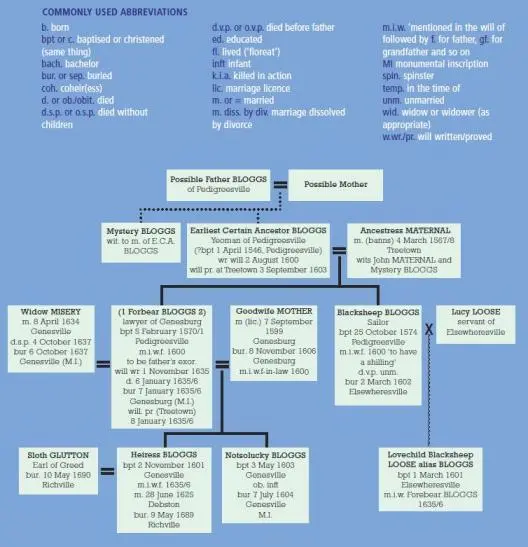
Equally, there are no rules about what you can or can’t include on a family tree. Put in as much or as little as you want and include as many families as you want, though beware of cluttering. I would recommend a minimum of full names, dates of birth or baptism, marriage and death or burial, where those events took place, and occupations. If your chart lacks any of these, it will be of little use to other researchers and, more importantly, it will be boring. If you know someone was crushed to death by a bear or invented the casserole dish, for goodness sake put it on the chart!
There are some sensible conventions and abbreviations, which you’ll need to know both for compiling your own charts and understanding other peoples’. These have been outlined above.
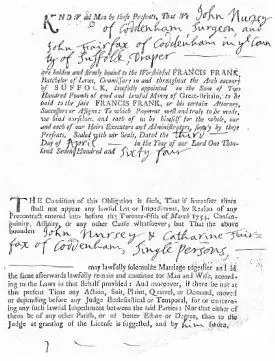
Marriage bond for John Nursey, surgeon of Coddenham, Suffolk.
When it comes to writing up the family history, you can, again, decide what to say and how to say it, and you can get ideas from the examples in this book and the many published family histories and articles in family history journals and magazines.
It’s a good idea to try to relate the events in the family to the world around them:
 Who was on the throne
Who was on the throne
 What wars and plagues would have concerned or affected them
What wars and plagues would have concerned or affected them
 What the places where they lived were like at the time
What the places where they lived were like at the time
 What their occupations entailed.
What their occupations entailed.
This is a valuable exercise, which might actually help you find out more about them, or highlight inaccuracies or even mistakes in the family tree. It is also a good reminder that these were real, breathing people who existed in the world, not as pale shadows on old, dusty records. Indeed, if you think your ancestors only existed within the confines of parish register entries and, now, the forms generated by genealogical computer programs, it’s unlikely you will gain very much from family history, or that other people will enjoy and benefit from your hard work. The more you can think of and convey the idea of your ancestors as real human beings, the more fun – and success – you’re likely to have.
HERE IS THE SAME information about the Fairfax family, presented as a narrative pedigree, a prose account and a traditional family tree.
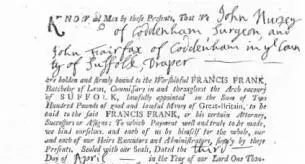 Читать дальше
Читать дальше



 Wiggly lines are for illegitimacy and ‘x’ for a union out of wedlock important on old pedigrees but less relevant today
Wiggly lines are for illegitimacy and ‘x’ for a union out of wedlock important on old pedigrees but less relevant today Wives usually go on the right of husbands, though only if that doesn’t interfere with the overall layout of the chart
Wives usually go on the right of husbands, though only if that doesn’t interfere with the overall layout of the chart

 Who was on the throne
Who was on the throne






